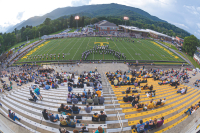Savagery taints classic town in King’s new novel
Under the Dome by Stephen King. Scribner, 2009. 1,074 pages
Before I had read 20 pages of Stephen King’s new opus, I found myself thinking about Thornton Wilder’s Our Town — not because the small town, Chester’s Mill in Under the Dome resembles Wilder’s Grover’s Corners, but because ... it doesn’t. Although Chester’s Mill is small (less than 3,000 people), provincial and — like Wilder’s classic small town — it has a generous number of eccentrics, misfits and delightful young people; however, appearances are deceptive. There is an underlying darkness and a raw, cynical attitude that never surfaced in Wilder’s Our Town. It is as though Chester’s Mill represents Grover’s Corner’s 50 years later.
Chester’s Mill has become a tarnished, corrupt little town in which the superficial veneer of civilized behavior strains to hold the town together. All that is needed is a catalyst — an unforeseen crisis that will test the town’s moral and spiritual resources (or reveal their absence). That catalyst is the Dome.
The Dome appears on a beautiful summer day when the inhabitants of “the Mill” are pursuing the innocent pleasures of any all-American town. Kids are fishing in the Prehistle Stream; a Seneca V drones over the town and an old woodchuck scampers along the shoulder of Highway 119 checking out the tidbits of fast food. Then, in an instant, an invisible barrier crashes down, causing a number of instant fatalities (including the old woodchuck).
The Dome encapsulates Chester’s Mill like an inverted bowl. Nothing can penetrate it, including birds, planes, cars and ballistic missiles. In a short time, the town’s boundaries are marked by a litter of corpses (human and animal) as well as the wreckage of crashed planes, cars and trucks. All attempts by the “outside world” (military and scientific) to breach the Dome fail. Eventually, the town is faced with life-threatening issues: lawlessness and the depletion of food, water and clean air.
In a sense, the plot of Under the Dome resembles the description of an inhuman laboratory experiment. As the inhabitants of Chester’s Mill struggle to survive, they begin to resemble a microscopic life forms in a petri dish. Within a week, the town government undergoes some radical changes: incompetent, mildly corrupt officials become increasingly oppressive. The police force begins to “beef up” by employing young men with a penchant for blue uniforms and approval of political leaders who readily endorse brutality. As a pleasant village morphs into a fascist nightmare, the violent and unethical changes are orchestrated by Jim Rennie, a scripture-spouting used car dealer (“You’ll be Wheeling, if Big Jim is dealing!”). Rennie is also one of the three Selectman (the New England equivalent of a governing board), and he is in total control. He also perceives the Dome as an opportunity for a personal kingdom.
Related Items
If King’s message were not obvious enough, he makes numerous references to William Golding’s Lord of the Flies, an English novel noted for its depiction of a group of English schoolboys who revert to savagery when they are marooned on a desert island. In addition, King occasionally paraphrases writers noted for their grim appraisal of mankind’s inherently brutal and godless nature. (T. S. Eliot’s The Wasteland, for example). Under the Dome also resembles Albert Camus’ The Plague, a novel, in which the inhabitants of a beleaguered town discover the similarities between a plague-ridden city and a civilization that is afflicted with an inner decay.
King presents Chester’s Mill as a microcosm of America. Although he acknowledges the courage and nobility of a small number of characters who struggle against the tides of lawless, it becomes increasingly obvious that their little town is doomed — primarily because their essential goodness makes them incapable of understanding the nature of their enemy or the crimes they are willing to commit to accomplish their ends. In a sense, Chester’s Mill’s week-long ordeal is a holocaust in miniature. All of the evils of the Third Reich, including the bigotry, the lust for power and the willingness to crush all resistance, blossoms and flourishes under the Dome.
Since Under the Dome contains more than 60 characters (and three memorable dogs), any discussion of personalities and their interaction becomes a daunting challenge. In addition, there are at least a dozen sub-plots that wind their way through this dark tale. A few of the most intense include: a serial murderer with a brain tumor; a newspaper editor who finds herself reduced to distributing photocopies when her office is burned; a minister who addresses her prayers to a deity she calls “Not There;” a veteran of the war in Iraq who finds his worst nightmares resurrected in Chester’s Mill; a Jesus-haunted fundamentalist minister who struggles to reconcile his conflicted roles in crack mill industry with his fervent religious beliefs; a town Selectman who becomes increasingly inept due to an Oxycontin addiction; a lecherous academic who finds a kind of redemption in the Chester’s Mill hospital, and a brutalized rape victim who decides to seek her own justice.
Under the Dome is vintage King. The novel’s tension builds slowly like a train that chugs out of the station and then gradually accelerates until it reaches a dizzying speed. Although this novel’s awesome number of characters makes it hard to keep track, King has provided his readers with a complete cast (along with a map of Chester’s Mill) in the book’s preface. The dialogue is brisk and colored with an assortment of dialects (including a misplaced New Orleans denizen) and a whole gaggle of teenage skateboarders who speak a delightful but bewildering jargon. This is a hell of a book.
What’s not to like? Well, yeah, there is one thing. The weakest link in the whole novel is ... the Dome. King’s final revelation ... it came from outer space! The somewhat whimsical departure of the Dome at the end of the book lacks credibility. Frankly, I don’t think this is a significant flaw. King’s raw and gritty tale of a small town going to hell needs a catalyst so that all of his bells, whistles and sirens could be launched. Any King reader knows that he is expected to “willingly suspend his disbelief.” In this case, that includes the acceptance of the Dome as being created by juvenile delinquents from outer space. Sounds reasonable to me!
(Gary Carden is a writer and storyteller who lives in Sylva. His most recent writings can be found on his blog, hollernotes.blogspot.com.)









